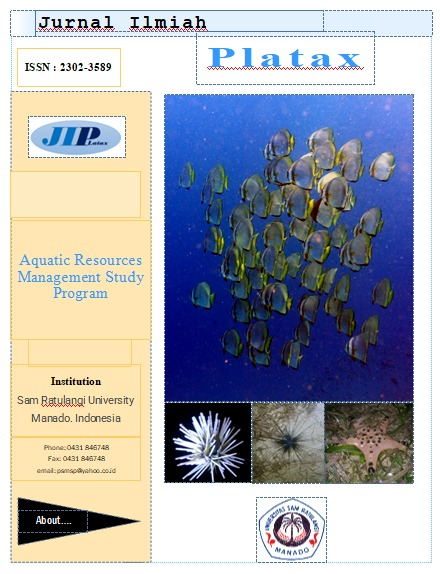Macroalgae Community Structure in Tanjung Merah Waters, Bitung City
DOI:
https://doi.org/10.35800/jip.9.1.2021.34427Keywords:
Macroalgae, Community, Diversity.Abstract
Seaweed is a component of coastal ecosystems that makes a major contribution to the Indonesian economy. This marine plant is a potential food source and industrial raw materials that can be used to improve people's welfare as these marine macroalgae are widely distributed in Indonesian waters. This study was carried out because of its important role for the ecosystems and the economy of the country. The purpose of this research is to determine the community structure of this macroalgae in the waters of Tanjung Merah Village of Matuari District of Bitung City. The data were collected from January 2021 to March 2021 using a transect of 1 x 1 m2 which was placed along a 100 m line transect with 5 m intervals. The macroalgae found were 6 species consisting of 2 types of Chlorophyta class and 4 species of Rhodophyta class. The macroalgae diversity index of around is 1.06 categorized as moderate diversity; the index of dominant is 0.44 moderate and the evenness index is 1.79 or low.
Keywords: Macroalgae; Community; Diversity.
Abstrak
Rumput laut merupakkan komponen ekosistem wilayah pesisir yang memberikkan kontribusi yang besar bagi ekonomi Indonesia. Potensi sumberdaya hayati laut Sulawesi Utara, khususnya Kota Bitung yang cukup potensial untuk dapat dimanfaatkan sebagai sumber pangan dan bahan baku industri guna peningkatan kesejahteran masyarakatkarena makroalga termasuk salah satu sumberdaya hayati laut yang banyak terdapat di perairan Indonesia. Makroalga memiliki potensi besar untuk dikembangkan, karena memiliki peranan penting baik dari aspek ekologi dan memiliki nilai ekonomi. Tujuan penelitian ini adalah untuk mengetahui struktur komunitas makroalga yang ada di perairan Kelurahan Tanjung Merah Kecamatan Matuari Kota Bitung. Penelitian ini dilaksanakan pada bulan Januari 2021 sampai Maret 2021. Data dikumpulkan dengan cara di sampling menggunakan kuadrat berukuran 1x 1 m2 yang diletakkan pada garis transek sepanjang 100 m dengan interval 5 m. Makroalga yang ditemukan 6 spesies yang terdiri atas Kelas Chlorophyta berjumlah 2 jenis, dan kelas Rhodophyta 4 jenis. Indeks keanekaragaman makroalga sekitar 1.06 dikategorikan sedang, indeks dominasi 0.44 dikategorikan rendah dan untuk indeks kemerataan 1,79 dikategorikkan rendah.
Kata kunci: Makroalga; Komunitas; Keanekaragaman
References
Ayhuan, H. V., Zamani, N. P., & Soedharma, D. (2017). Analisis Struktur Komunitas Makroalga Ekonomis Penting di Perairan Intertidal Manokwari, Papua Barat. Jurnal Teknologi Perikanan dan Kelautan, 8(1), 19-38.
Anggadiredja, J.T. 1998. Ethnobotany study of seaweed diversity and its utilization in Warambadi, Panguhalodo areas of East Sumba District. Jurnal Teknologi Lingkungan 10(3): 297-310.
Ayhuan, H.V. 2017. Studi analisis interaksi makroalga dengan parameter lingkungan di perairan Manokwari Papua Barat. Tesis. Sekolah Pascasarjana Institut Pertanian Bogor. 87 hal.
Calumpong, H.P. and E.G. Meñez. 1997. Field guide to the common mangroves: seagrasses and algae of the Philippines. Bookmark, Inc. Makati City, Philippines. 197 p.
Baino, I., Kepel, R., & Manu, G. (2019). The biodiversity of macroalgae in the coastal waters of Bahoi Village, West Likupang Sub-District, North Minahasa Regency. Jurnal Ilmiah PLATAX, 7(1), 134-141. doi:https://doi.org/10.35800/jip.7.1.2019.22595
Bartsch, I., C. Wiencke and T. Laepple. 2012. Global seaweed biogeography under a changing climate: the prospected effects of temperature. pp. 383–406. In: Wiencke, C. and K. Bischof (eds.). Seaweed Biology, Ecological Studies 219. Springer-Verlag, Berlin, Heidelberg.
Kadi, A. 2014. Kepadatan rumput laut alami di perairan Teluk Kolono, Konowe Selatan, Sulawesi Tenggara. Jurnal Oseanologi dan Limnologi di Indonesia (OLDI) 40 (2): 203-210.
Kepel, R., & Mantiri, D. (2019). The biodiversity of macroalgae in the coastal waters of Kora-Kora, East Lembean Sub-District, Minahasa Regency. Jurnal Ilmiah PLATAX, 7(2), 383-393. doi: https://doi.org/10.35800/jip.7.2.2019.23727
Kepel, R.C., L.J.L. Lumingas, P.M.M. Watung and D.M.H. Mantiri. 2019a. Community structure of seaweeds along the intertidal zone of Mantehage Island, North Sulawesi, Indonesia. AACL Bioflux 12(1): 87-101.
Kepel, R.C., L.J.L. Lumingas, J.L. Tombokan and D.M.H. Mantiri. 2019b. Biodiversity and community structure of seaweeds in Minahasa Peninsula, North Sulawesi, Indonesia. AACL Bioflux 12(3): 880-892.
Kepel, R.C., L.J.L. Lumingas, J.L. Tombokan and D.M.H. Mantiri. 2020. Community structure of seaweeds in dry season in Minahasa Peninsula, North Sulawesi, Indonesia. AACL Bioflux 13(1): 392-402.
Kepel, R., Mantiri, D., & Nasprianto, -. (2018). The biodiversity of macroalgae in the coastal waters of Tongkaina, Manado City. Jurnal Ilmiah PLATAX, 6(1), 160-173. doi:https://doi.org/10.35800/jip.6.1.2018.19558
Kepel, R.C., D.M.H. Mantiri, D.S.J. Paransa, J.J.H. Paulus, Nasprianto and B.T. Wagey. 2018c. Arsenic content, cell structure, and pigment of Ulva sp. from Totok Bay and Blongko waters, North Sulawesi, Indonesia. AACL Bioflux 11(3): 765-772.
Kim, S.K. 2012. Handbook on marine macroalgae: biotechnology and applied phycology. John Wiley and Sons, Ltd Publi. New Delhi, India. 567 p.
Krebs, C.J. 1999. Ecological methodology. Second Edition. Addison Wesley Longman, Inc. New York.
Kumar, M. and P. Ralph. 2017. Systems biology of marine ecosystems. Springer. 355 p.
Lee, R.E. 2008. Phycology. Fourth edition. Cambridge University Press. 547 p.
Lewmanomount, K. and H. Ogawa. 1995. Common seaweeds and seagrasses of Thailand. Integrated Promotion Technology Co, Ltd. Faculty of Fisheries. Kasetsart University. 163 p.
Downloads
Published
How to Cite
Issue
Section
License
COPYRIGHT
Authors who publish with this journal agree to the following terms:
Authors hold their copyright and grant this journal the privilege of first publication, with the work simultaneously licensed under a Creative Commons Attribution License that permits others to impart the work with an acknowledgment of the work's origin and initial publication by this journal.
Authors can enter into separate or additional contractual arrangements for the non-exclusive distribution of the journal's published version of the work (for example, post it to an institutional repository or publish it in a book), with an acknowledgment of its underlying publication in this journal.
Authors are permitted and encouraged to post their work online (for example, in institutional repositories or on their website) as it can lead to productive exchanges, as well as earlier and greater citation of the published work (See The Effect of Open Access).






































